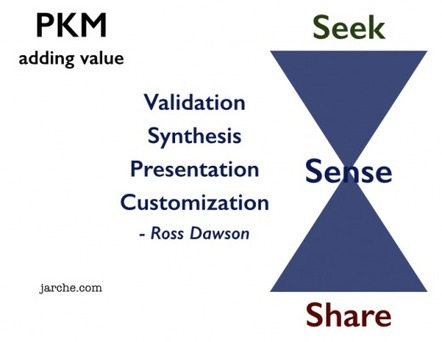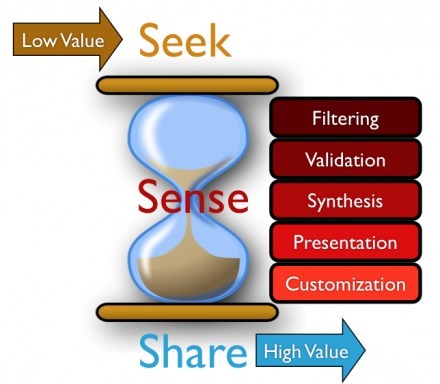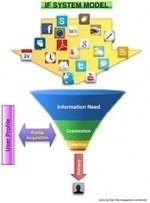"...I want to point out that people with better PKM skills, an ability to create higher value information, and a willingness to share it, will become more valued members (nodes) in their professional networks." (Harold Jarche)
Robin Good: In this short article analyzing the PKM (personal knowledge management) process it is interesting to note the strong affinity it has with curation.
"The critical part of PKM is in personalizing information and experience, or to use a business term, adding value.
Ross Dawson shows five ways to add value to information (my examples/descriptions follow):
1) Filtering (separating signal from noise, based on some criteria)
2) Validation (ensuring that information is reliable, current or supported by research)
3) Synthesis (describing patterns, trends or flows in large amounts of information)
4) Presentation (making information understandable through visualization or logical presentation)
5) Customization (describing information in context)."
More info and examples presented in the article do not seem to include yet the appearance of a trusted news curator as a means to develop such PKM, which although is defined as "an individually created process", it could rely in the near future not just on tools, but also on the filtering and curation work of other humans.
Or not?
Thoughtful. 8/10.
Full article: http://www.jarche.com/2010/03/sense-making/ ;
Via
Robin Good,
Jim Lerman
 Your new post is loading...
Your new post is loading...
 Your new post is loading...
Your new post is loading...














This is definately something that anyone in the coming new century needs to learn how to do effectively. Do we want regurgitation or depth of learning from knowledge gained? I value, for example, how Scoop.it allows for the 'web interface' to be looked after, by them ,and the curation and learning happens with us!
Thanks for sharing this Robin Good!
Robin's insights always bring content to the next level!
Article lists a range of ways to use sense-making to add value to curated content.